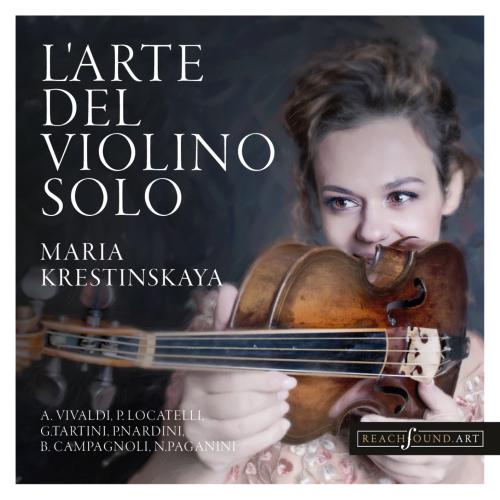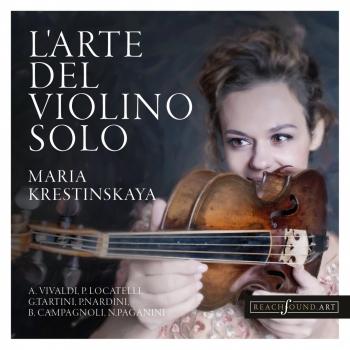
L'arte del violino solo Maria Krestinskaya
Album Info
Album Veröffentlichung:
2021
HRA-Veröffentlichung:
24.05.2021
Label: ReachSound.Art
Genre: Classical
Subgenre: Concertos
Interpret: Maria Krestinskaya
Komponist: Antonio Vivaldi (1678-1741)
Das Album enthält Albumcover
Entschuldigen Sie bitte!
Sehr geehrter HIGHRESAUDIO Besucher,
leider kann das Album zurzeit aufgrund von Länder- und Lizenzbeschränkungen nicht gekauft werden oder uns liegt der offizielle Veröffentlichungstermin für Ihr Land noch nicht vor. Wir aktualisieren unsere Veröffentlichungstermine ein- bis zweimal die Woche. Bitte schauen Sie ab und zu mal wieder rein.
Wir empfehlen Ihnen das Album auf Ihre Merkliste zu setzen.
Wir bedanken uns für Ihr Verständnis und Ihre Geduld.
Ihr, HIGHRESAUDIO
- Pietro Antonio Locatelli (1695 - 1764): L'arte del violino, Op. 3, L 2605 "il Laberinto Armonico":
- 1 Locatelli: L'arte del violino, Op. 3, L 2605 "il Laberinto Armonico": No. 23, Capriccio 03:47
- Giuseppe Tartini (1692 - 1770): Violin Sonata in G Minor in G Minor, B. g5 "Le trille du diable":
- 2 Tartini: Violin Sonata in G Minor in G Minor, B. g5 "Le trille du diable": I. Larghetto affetuoso (Arr. for Solo Violin by Maria Krestinskaya) 05:32
- 3 Tartini: Violin Sonata in G Minor in G Minor, B. g5 "Le trille du diable": II. Tempo giusto (Arr. for Solo Violin by Maria Krestinskaya) 06:21
- 4 Tartini: Violin Sonata in G Minor in G Minor, B. g5 "Le trille du diable": III. Andante (Arr. for Solo Violin by Maria Krestinskaya) 06:48
- Pietro Nardini (1722 - 1793):
- 5 Nardini: Capriccio No. 1 for Solo Violin in C Minor 04:13
- Bartolomeo Campagnoli (1751 - 1827): Preludio "Capriccio" No. 1 for Solo Violin in F Minor:
- 6 Campagnoli: Preludio "Capriccio" No. 1 for Solo Violin in F Minor: No. 24, Presto 01:59
- Niccolò Paganini (1782 - 1840): Variations "Nel cor piu non mi sento" for Violin Solo in G Major:
- 7 Paganini: Variations "Nel cor piu non mi sento" for Violin Solo in G Major: No. 1, Introduction. Capriccio 01:52
- 8 Paganini: Variations "Nel cor piu non mi sento" for Violin Solo in G Major: II. Tema. Andante 01:56
- 9 Paganini: Variations "Nel cor piu non mi sento" for Violin Solo in G Major: III. var.1 Brilliantе 02:17
- 10 Paganini: Variations "Nel cor piu non mi sento" for Violin Solo in G Major: IV. vari.2 tremolo 01:34
- 11 Paganini: Variations "Nel cor piu non mi sento" for Violin Solo in G Major: V. var 3 Piu lento 02:02
- 12 Paganini: Variations "Nel cor piu non mi sento" for Violin Solo in G Major: VI. var 4 Allegro 01:08
- 13 Paganini: Variations "Nel cor piu non mi sento" for Violin Solo in G Major: VII. var 5 01:29
- 14 Paganini: Variations "Nel cor piu non mi sento" for Violin Solo in G Major: VIII. var 6 Appasionato 02:05
- 15 Paganini: Variations "Nel cor piu non mi sento" for Violin Solo in G Major: IX. var 7 Vivace. Coda 02:06
- Antonio Vivaldi (1678 - 1741):
- 16 Vivaldi: Violin Concerto in D Major "Grosso Mogul" in D Major, RV 208 (Arr. for Solo Violin by Maria Krestinskaya) 02:56
Info zu L'arte del violino solo
Maria Krestinskaya's new album for solo violin, recorded in the midst of the covid 19 pandemic. "L'arte del violino solo" is a full-fledged journey through Italian violin music from musical baroque, classicism to romanticism, from Antonio Vivaldi to Niccolo Paganini. When recording the album, in accordance with the eras, three different violins, bows and musical tunes were used. The new issue includes such popular works as: "Labyrinth" by P. Locatelli, "Devil's Trill" by D. Tartini, "Molinara" by N. Paganini.
New album of Maria Krestinskayahe "L'arte del Violino Solo" is an entire journey taking the listeners from the early baroque trough to the romantic era. Its essence lies in gradual movement from the early days through to the development and golden age of the virtuoso style that originated in Italy around the first third of the 18th century and has steadfastly survived to this day. This style inspired the great composers and violinists of the past to search for new approaches and master most intricate violin techniques. As a result, we are able to enjoy compilation albums of virtuoso Capriccios (meaning “a fantasy” or “a fancy frill” in Italian), each of them being a self-sufficient piece helping musicians of all times perfect their performance and skill. Every Capriccio has its main theme, a sophisticated element gradually going from simple to complex throughout the piece. Hence, there is no choice but to master and perfect the technique while playing. In 19th century such form of music became widely known as études. It should be noted that in the 17th century Capriccios were mostly viewed as fantasy pieces with little or no focus on complexity.
The program aspires to take the listeners through the development and evolution of the form and substance, the choice of music focuses on continuity with all the pieces having something in common and combining into a dramaturgic and meaningful action. Metamorphoses emerge as we move from piece to piece, a longer bow, a higher pitch, more and more demanding and emotionally elevated performance; however, the main character remains the same – her majesty the violin.
Three different violins with bows to match have helped to maintain the performance authentic throughout the program. The first one is an authentic baroque violin made in 1627 by Jovanni Paolo Maggini and tuned to 415 Hz. This violin is the best for performing Locatelli’s Capriccio and Tartini’s Devil Trill. The second violin is a classic instrument made in 2019 by Alexander Rabinovitch, one of the best violin makers of our time, and tuned to 430 Hz. The instrument has a deep and vibrant tone required for classical music and it sounds perfect with gut strings and in tandem with a bow to match made by Eugene Ivanov in 2017. The third violin is a modern instrument carefully assembled by Alexander Rabinovitch in 2011 and tuned to 440 Hz. Being extremely demanding in terms of sound quality and intonation, Paganini’s music dictates some delicate attention to the instrument, especially when one uses gut strings. This violin is perfectly capable of demonstrating all the illustrious brilliance of Paganini’s variations while also keeping its own gentle and romantic tone. For the "Nel Cor piu non mi Sento" variations I have chosen a bow after Tourte specifically made by Alexander Rabinovitch in 2019. All the three violins complement each other flawlessly creating varied and complex acoustic effects.
"For this Album I choosed three different violins with bows to match have helped to maintain the performance authentic throughout the program.
The first one is an authentic baroque violin made in 1627 by Jovanni Paolo Maggini and tuned to 415 Hz. This violin is the best for performing Locatelli’s Capriccio and Tartini’s Devil Trill.
The second violin is a classic instrument made in 2019 by Alexander Rabinovitch, one of the best violin makers of our time, and tuned to 430 Hz. The instrument has a deep and vibrant tone required for classical music and it sounds perfect with gut strings and in tandem with a bow to match made by Eugene Ivanov in 2017.
The third violin is a modern instrument carefully assembled by Alexander Rabinovitch in 2011 and tuned to 440 Hz. Being extremely demanding in terms of sound quality and intonation, Paganini’s music dictates some delicate attention to the instrument, especially when one uses gut strings. This violin is perfectly capable of demonstrating all the illustrious brilliance of Paganini’s variations while also keeping its own gentle and romantic tone. For the "Nel Cor piu non mi Sento" variations I have chosen a bow after Tourte specifically made by Alexander Rabinovitch in 2019. All the three violins complement each other flawlessly creating varied and complex acoustic effects.
Maria Krestinskaya, violin
Maria Krestinskaya
Began studying the violin at the age of seven with Professor Georgy Tagauri in Tbilisi. Graduated from the special lyceum school of music of the St Petersburg Conservatoire (class of Neli Sklyarskaya) and from the conservatoire itself with distinction (class of Professor Ovcharek). Became a grant recipient of the Mstislav Rostropovich Foundation.
She began to become engages in authentic performance in 1998, working with the St Petersburg early music ensemble Musica Petropolitana and Andrei Reshetin. Took master-classes from Zakhar Bron, Boris Kuschnir, Marie Leonhardt, Andrew Manze, Monica Huggett, Peter van Heyghen and Andrew Lawrence-King.
Prize-winner at the Jascha Heifetz International Violin Competition in Vilnius and the Alexander Glazunov International Competition in Paris.
Since 2001 she has appeared with the Orchestra of Catherine the Great (since 2007 the Soloists of Catherine the Great ensemble) under Andrei Reshetin.
Has taken part in a production of Paisiello's opera I filosofi immaginari, performed at the Oude Muziek festival in Utrecht and the Early Music festival in St Petersburg (2003), as well as the premiere of Mattheson's opera Boris Goudenow at the Boston Early Music Festival (2005). Since 2011 she has collaborated with the Russian-Estonian ensemble Baltic Baroque, which ran the Vivaldi Collection project – a recording of all of Vivaldi's instrumental works. Performs with Dmitry Sinkovsky's ensemble La Voce Strumentale (Moscow) and directs the ensemble Barocco Concertato which she founded.
In 2014 Maria Krestinskaya appeared as guest leader of the orchestra Il Complesso Barocco at the premiere of the first contemporary production of Gluck's Demofoonte (Theater an der Wien, conductor – Alan Curtis).
Dieses Album enthält kein Booklet













